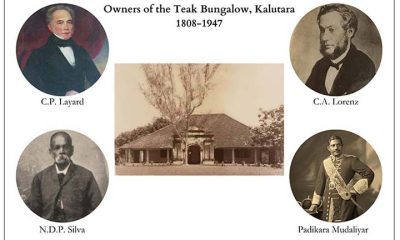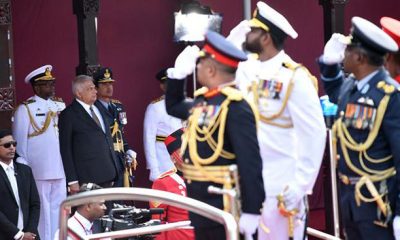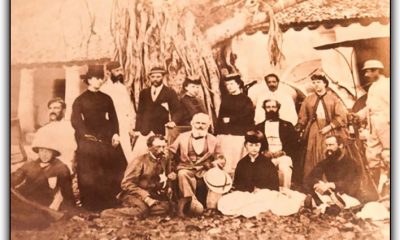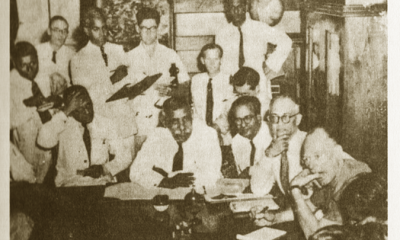Features
From Ceylon to Sri Lanka: some historical and other snippets
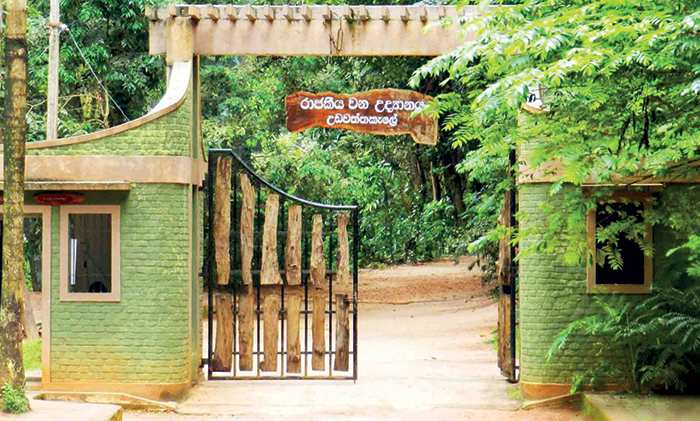
by ACB Pethiyagoda
“Oh! Great King, the birds of the air and beasts have an equal right to live and move about in any part of this land as thou. The land belongs to the people and all other beings and thou art only the guardian of it. “
Most readers, particularly Buddhists, will know that these words of advice were given to King Devanampiyatissa (250-210 BC) by the Ven Mahinda Thera, son of Emperor Dharma Asoka of India, who gave the greatest gift to Sri Lanka – the teachings of the Buddha.
It is not surprising that Max Morgan-Davies quoted these words in his book ‘From Ceylon to Sri Lanka: experiences of a naturalist tea planter’ as he spent about five decades of his life in various capacities in wild life protection and conservation in Tanganyika, Nigeria and Malawi. The tea planter position comes in as he begins his working life as an assistant superintendent of Ury Group in Passara in 1949. He moved up to the position of a superintendent and resigned in 1959 to assume duties as an assistant game warden in Tanganyika.
Apparently his love for Sri Lanka drew him back here in 2002, 2004 and 2005 for varying periods of time. During his stays here he went to the jungles in all parts of the country and learnt a great deal about wildlife, the people in those remote villages, their way of life, their folk lore, habits and customs, which he records in his very readable book. He enjoyed his shoots in the highland patnas and lowland jungles as a sport and for the pot – major credit for his success going to the villagers who accompanied him. Fortunately for him and most certainly for the country (belated though it was) the ban on shooting of animals came in as law in 1964, and birds in 1993.
Morgan-Davies writes about Udawattakele in Kandy. Since Trinity College is on its borders it has touched the lives of practically all Trinitians, particularly those who studied Botany, those who were athletes, and those who took part in cross country runs. Boarders would scoot out for a spout bath or stroll on a Saturday or Sunday. It is also known as Lady Horton’s. Legend has it that a devil or evil spirit who resided there took a `bills’ every now and then by enticing a likely bather in the pond at the top of the jungle with a floating golden bowl and dragged him or her to a watery grave.
During WWII Lord Louis Mountbatten as Supreme Allied Commander of South and South East Asia occupied the King’s Pavilion (now HE the President’s Kandy residence) which is also on the periphery of Udawattakele. Some of us boarders on a walk during the weekend, saw Lord Louis on horseback with three or four horse riding women accompanying him.
They very cordially returned our greetings of ‘Good Morning’ with friendly smiles. This motivated more walks among the giant trees by Trinity boarders in the hope of seeing the Commander and his attractive riding retinue!
Some years ago when the Mahaveli Project was at the height of its progress, its emblem of a seven hooded cobra was displayed very prominently on the Al road a little beyond Warakapola town on the left of the road when proceeding towards Kandy. It was obviously of some historical importance related to agriculture but people I then asked could not give me a satisfactory answer with regard to its origins.
Morgan Davies does in his book. The origin is a monolith abut 1.5 metres in height dating back to the third century BC beside the sluice gate of Suriyawewa along the road from Ambalangoda to Yala.
Morgan –Davies writes that the Great and Little (Lesser) Basses lighthouses built in 1878 are about 28 miles apart in the seas off Kirinde and Kumana. Although built by the British the word ‘basses’ is Portuguese, so there is conjecturing as to the reason for the use of a non-English word.
However, there was no doubt about the sturdy building of the lighthouses; they resisted the tsunami waves of 2004 and stood undamaged. More interesting is the strip of land beside and below the road from Palatupana to Sithulpahuwa with the Magulmaha Vihara on top of which is a small cave with a fine view of the surroundings country side.
“This secluded grotto”, the author had been informed by the caretaker, “was used many hundreds of years ago as a honeymoon retreat by King Kavan Tissa of Ruhuna and Queen Maha Devi” (He means Queen Viharamaha Devi). That’s a good story related by a man who could romanticize ancient and unrecorded history. I have visited these areas many times over but never was fortunate enough to have legend and myth whispered in my ear. Maybe the colour of my skin was not conducive to being made privy to such tales.
Morgan-Davies writing about Prince Gemunu’s army of 10,000 men and women recruited to end the 35 years of Tamil dominance in the north central part of the country had 500 bhikkhus to see to the spiritual needs of the enlisted persons. This reminded me of the Bhikkhu who disrobed and joined the army to fight in Eelam War IV. I wonder whether he is still in the army, perhaps beautifying Colombo, or in robes again in civvy street after all the training to kill before getting killed.
Interestingly, the author writes of a difference of opinion about who was Dutugemunu’s queen. Some, he writes, believe it was Ran Etana, the daughter of a Ruhunu Chief who gathered an army herself and fought wars along with the Prince; while others consider her to be a damsel from Kotmale where Prince Gamini lived for some time training his army. The folk story I have heard is that it was the Kandyan beauty who became the queen.
Mention is also made that King Dutugemunu’s son Saliiya, did not succeed him to the throne as he married a Rodiya girl, Asokamala.
Mention is made in the book of the dagoba earlier called Ruwanwelle and now Ruwanvelisaya in Anuradhapura which is in the shape of a bubble of water while others could be in one of the shapes of a bell, pot of water, lotus, or heap of paddy. I cannot recall the exact year when the huge crystal gifted by Burma and locally called Chudamanikka was placed atop the restored Ruwanvelisaya. It was in the late 1930s. The occasion is well remembered as our mother went to Anuradhapura with her parents to participate in the ceremony, leaving my sisters and me in the care of an aunt in Kandy.
We knew the auspicious time when the crystal was placed by phenomena that I well remember. It was a hot sunny afternoon but suddenly a heavy downpour occurred for a couple of minutes. Then to our utter surprise we could look at the sun direct as it dimmed, not with clouds but unusually.
The time was around 4.00 in the afternoon. This was the exact time of placing the crystal. Later we learnt that a sprinkle of rain had fallen in Anuradhapura as well, with other manifestations like jasmines in the air. In those times no helicopters did the shedding of flowers!
To the author, Kandula, Prince Gemunu’s royal tusker belonging to the Saddantha caste, the highest of the ten among elephants, appears to be of great interest. In those times people wouldn’t have even dreamt of human/elephant problems which today is that serious with 14 elephants and 21 people having lost their lives in the battle for survival in the first six months of the year.
We are saddened to the point of tears reading regularly of elephants dying gruesome and slow deaths from shattered jaws by picking up unknowingly explosive devices left by farmers to get rid of these animals destroying their crops. Bread winners mostly have also died in their encounters with elephants.
The conflict is worsening with more and more jungles being cleared. If Ven Mahinda Thera were to visit us again he would be mightly surprised. Instead of the intelligent king who welcomed him and his dignified people, he will find a race that has gone bananas!
(This was first published in this newspaper in Oct. 2011. The later writer who was a career planted worked post-retirement from the plantation industry for Ceylon Tobacco Co. Ltd. In agricultural projects.)
Features
The heart-friendly health minister

by Dr Gotabhya Ranasinghe
Senior Consultant Cardiologist
National Hospital Sri Lanka
When we sought a meeting with Hon Dr. Ramesh Pathirana, Minister of Health, he graciously cleared his busy schedule to accommodate us. Renowned for his attentive listening and deep understanding, Minister Pathirana is dedicated to advancing the health sector. His openness and transparency exemplify the qualities of an exemplary politician and minister.
Dr. Palitha Mahipala, the current Health Secretary, demonstrates both commendable enthusiasm and unwavering support. This combination of attributes makes him a highly compatible colleague for the esteemed Minister of Health.
Our discussion centered on a project that has been in the works for the past 30 years, one that no other minister had managed to advance.
Minister Pathirana, however, recognized the project’s significance and its potential to revolutionize care for heart patients.
The project involves the construction of a state-of-the-art facility at the premises of the National Hospital Colombo. The project’s location within the premises of the National Hospital underscores its importance and relevance to the healthcare infrastructure of the nation.
This facility will include a cardiology building and a tertiary care center, equipped with the latest technology to handle and treat all types of heart-related conditions and surgeries.
Securing funding was a major milestone for this initiative. Minister Pathirana successfully obtained approval for a $40 billion loan from the Asian Development Bank. With the funding in place, the foundation stone is scheduled to be laid in September this year, and construction will begin in January 2025.
This project guarantees a consistent and uninterrupted supply of stents and related medications for heart patients. As a result, patients will have timely access to essential medical supplies during their treatment and recovery. By securing these critical resources, the project aims to enhance patient outcomes, minimize treatment delays, and maintain the highest standards of cardiac care.
Upon its fruition, this monumental building will serve as a beacon of hope and healing, symbolizing the unwavering dedication to improving patient outcomes and fostering a healthier society.We anticipate a future marked by significant progress and positive outcomes in Sri Lanka’s cardiovascular treatment landscape within the foreseeable timeframe.
Features
A LOVING TRIBUTE TO JESUIT FR. ALOYSIUS PIERIS ON HIS 90th BIRTHDAY

by Fr. Emmanuel Fernando, OMI
Jesuit Fr. Aloysius Pieris (affectionately called Fr. Aloy) celebrated his 90th birthday on April 9, 2024 and I, as the editor of our Oblate Journal, THE MISSIONARY OBLATE had gone to press by that time. Immediately I decided to publish an article, appreciating the untiring selfless services he continues to offer for inter-Faith dialogue, the renewal of the Catholic Church, his concern for the poor and the suffering Sri Lankan masses and to me, the present writer.
It was in 1988, when I was appointed Director of the Oblate Scholastics at Ampitiya by the then Oblate Provincial Fr. Anselm Silva, that I came to know Fr. Aloy more closely. Knowing well his expertise in matters spiritual, theological, Indological and pastoral, and with the collaborative spirit of my companion-formators, our Oblate Scholastics were sent to Tulana, the Research and Encounter Centre, Kelaniya, of which he is the Founder-Director, for ‘exposure-programmes’ on matters spiritual, biblical, theological and pastoral. Some of these dimensions according to my view and that of my companion-formators, were not available at the National Seminary, Ampitiya.
Ever since that time, our Oblate formators/ accompaniers at the Oblate Scholasticate, Ampitiya , have continued to send our Oblate Scholastics to Tulana Centre for deepening their insights and convictions regarding matters needed to serve the people in today’s context. Fr. Aloy also had tried very enthusiastically with the Oblate team headed by Frs. Oswald Firth and Clement Waidyasekara to begin a Theologate, directed by the Religious Congregations in Sri Lanka, for the contextual formation/ accompaniment of their members. It should very well be a desired goal of the Leaders / Provincials of the Religious Congregations.
Besides being a formator/accompanier at the Oblate Scholasticate, I was entrusted also with the task of editing and publishing our Oblate journal, ‘The Missionary Oblate’. To maintain the quality of the journal I continue to depend on Fr. Aloy for his thought-provoking and stimulating articles on Biblical Spirituality, Biblical Theology and Ecclesiology. I am very grateful to him for his generous assistance. Of late, his writings on renewal of the Church, initiated by Pope St. John XX111 and continued by Pope Francis through the Synodal path, published in our Oblate journal, enable our readers to focus their attention also on the needed renewal in the Catholic Church in Sri Lanka. Fr. Aloy appreciated very much the Synodal path adopted by the Jesuit Pope Francis for the renewal of the Church, rooted very much on prayerful discernment. In my Religious and presbyteral life, Fr.Aloy continues to be my spiritual animator / guide and ongoing formator / acccompanier.
Fr. Aloysius Pieris, BA Hons (Lond), LPh (SHC, India), STL (PFT, Naples), PhD (SLU/VC), ThD (Tilburg), D.Ltt (KU), has been one of the eminent Asian theologians well recognized internationally and one who has lectured and held visiting chairs in many universities both in the West and in the East. Many members of Religious Congregations from Asian countries have benefited from his lectures and guidance in the East Asian Pastoral Institute (EAPI) in Manila, Philippines. He had been a Theologian consulted by the Federation of Asian Bishops’ Conferences for many years. During his professorship at the Gregorian University in Rome, he was called to be a member of a special group of advisers on other religions consulted by Pope Paul VI.
Fr. Aloy is the author of more than 30 books and well over 500 Research Papers. Some of his books and articles have been translated and published in several countries. Among those books, one can find the following: 1) The Genesis of an Asian Theology of Liberation (An Autobiographical Excursus on the Art of Theologising in Asia, 2) An Asian Theology of Liberation, 3) Providential Timeliness of Vatican 11 (a long-overdue halt to a scandalous millennium, 4) Give Vatican 11 a chance, 5) Leadership in the Church, 6) Relishing our faith in working for justice (Themes for study and discussion), 7) A Message meant mainly, not exclusively for Jesuits (Background information necessary for helping Francis renew the Church), 8) Lent in Lanka (Reflections and Resolutions, 9) Love meets wisdom (A Christian Experience of Buddhism, 10) Fire and Water 11) God’s Reign for God’s poor, 12) Our Unhiddden Agenda (How we Jesuits work, pray and form our men). He is also the Editor of two journals, Vagdevi, Journal of Religious Reflection and Dialogue, New Series.
Fr. Aloy has a BA in Pali and Sanskrit from the University of London and a Ph.D in Buddhist Philosophy from the University of Sri Lankan, Vidyodaya Campus. On Nov. 23, 2019, he was awarded the prestigious honorary Doctorate of Literature (D.Litt) by the Chancellor of the University of Kelaniya, the Most Venerable Welamitiyawe Dharmakirthi Sri Kusala Dhamma Thera.
Fr. Aloy continues to be a promoter of Gospel values and virtues. Justice as a constitutive dimension of love and social concern for the downtrodden masses are very much noted in his life and work. He had very much appreciated the commitment of the late Fr. Joseph (Joe) Fernando, the National Director of the Social and Economic Centre (SEDEC) for the poor.
In Sri Lanka, a few religious Congregations – the Good Shepherd Sisters, the Christian Brothers, the Marist Brothers and the Oblates – have invited him to animate their members especially during their Provincial Congresses, Chapters and International Conferences. The mainline Christian Churches also have sought his advice and followed his seminars. I, for one, regret very much, that the Sri Lankan authorities of the Catholic Church –today’s Hierarchy—- have not sought Fr.
Aloy’s expertise for the renewal of the Catholic Church in Sri Lanka and thus have not benefited from the immense store of wisdom and insight that he can offer to our local Church while the Sri Lankan bishops who governed the Catholic church in the immediate aftermath of the Second Vatican Council (Edmund Fernando OMI, Anthony de Saram, Leo Nanayakkara OSB, Frank Marcus Fernando, Paul Perera,) visited him and consulted him on many matters. Among the Tamil Bishops, Bishop Rayappu Joseph was keeping close contact with him and Bishop J. Deogupillai hosted him and his team visiting him after the horrible Black July massacre of Tamils.
Features
A fairy tale, success or debacle

Sri Lanka-Singapore Free Trade Agreement
By Gomi Senadhira
senadhiragomi@gmail.com
“You might tell fairy tales, but the progress of a country cannot be achieved through such narratives. A country cannot be developed by making false promises. The country moved backward because of the electoral promises made by political parties throughout time. We have witnessed that the ultimate result of this is the country becoming bankrupt. Unfortunately, many segments of the population have not come to realize this yet.” – President Ranil Wickremesinghe, 2024 Budget speech
Any Sri Lankan would agree with the above words of President Wickremesinghe on the false promises our politicians and officials make and the fairy tales they narrate which bankrupted this country. So, to understand this, let’s look at one such fairy tale with lots of false promises; Ranil Wickremesinghe’s greatest achievement in the area of international trade and investment promotion during the Yahapalana period, Sri Lanka-Singapore Free Trade Agreement (SLSFTA).
It is appropriate and timely to do it now as Finance Minister Wickremesinghe has just presented to parliament a bill on the National Policy on Economic Transformation which includes the establishment of an Office for International Trade and the Sri Lanka Institute of Economics and International Trade.
Was SLSFTA a “Cleverly negotiated Free Trade Agreement” as stated by the (former) Minister of Development Strategies and International Trade Malik Samarawickrama during the Parliamentary Debate on the SLSFTA in July 2018, or a colossal blunder covered up with lies, false promises, and fairy tales? After SLSFTA was signed there were a number of fairy tales published on this agreement by the Ministry of Development Strategies and International, Institute of Policy Studies, and others.
However, for this article, I would like to limit my comments to the speech by Minister Samarawickrama during the Parliamentary Debate, and the two most important areas in the agreement which were covered up with lies, fairy tales, and false promises, namely: revenue loss for Sri Lanka and Investment from Singapore. On the other important area, “Waste products dumping” I do not want to comment here as I have written extensively on the issue.
1. The revenue loss
During the Parliamentary Debate in July 2018, Minister Samarawickrama stated “…. let me reiterate that this FTA with Singapore has been very cleverly negotiated by us…. The liberalisation programme under this FTA has been carefully designed to have the least impact on domestic industry and revenue collection. We have included all revenue sensitive items in the negative list of items which will not be subject to removal of tariff. Therefore, 97.8% revenue from Customs duty is protected. Our tariff liberalisation will take place over a period of 12-15 years! In fact, the revenue earned through tariffs on goods imported from Singapore last year was Rs. 35 billion.
The revenue loss for over the next 15 years due to the FTA is only Rs. 733 million– which when annualised, on average, is just Rs. 51 million. That is just 0.14% per year! So anyone who claims the Singapore FTA causes revenue loss to the Government cannot do basic arithmetic! Mr. Speaker, in conclusion, I call on my fellow members of this House – don’t mislead the public with baseless criticism that is not grounded in facts. Don’t look at petty politics and use these issues for your own political survival.”
I was surprised to read the minister’s speech because an article published in January 2018 in “The Straits Times“, based on information released by the Singaporean Negotiators stated, “…. With the FTA, tariff savings for Singapore exports are estimated to hit $10 million annually“.
As the annual tariff savings (that is the revenue loss for Sri Lanka) calculated by the Singaporean Negotiators, Singaporean $ 10 million (Sri Lankan rupees 1,200 million in 2018) was way above the rupees’ 733 million revenue loss for 15 years estimated by the Sri Lankan negotiators, it was clear to any observer that one of the parties to the agreement had not done the basic arithmetic!
Six years later, according to a report published by “The Morning” newspaper, speaking at the Committee on Public Finance (COPF) on 7th May 2024, Mr Samarawickrama’s chief trade negotiator K.J. Weerasinghehad had admitted “…. that forecasted revenue loss for the Government of Sri Lanka through the Singapore FTA is Rs. 450 million in 2023 and Rs. 1.3 billion in 2024.”
If these numbers are correct, as tariff liberalisation under the SLSFTA has just started, we will pass Rs 2 billion very soon. Then, the question is how Sri Lanka’s trade negotiators made such a colossal blunder. Didn’t they do their basic arithmetic? If they didn’t know how to do basic arithmetic they should have at least done their basic readings. For example, the headline of the article published in The Straits Times in January 2018 was “Singapore, Sri Lanka sign FTA, annual savings of $10m expected”.
Anyway, as Sri Lanka’s chief negotiator reiterated at the COPF meeting that “…. since 99% of the tariffs in Singapore have zero rates of duty, Sri Lanka has agreed on 80% tariff liberalisation over a period of 15 years while expecting Singapore investments to address the imbalance in trade,” let’s turn towards investment.
Investment from Singapore
In July 2018, speaking during the Parliamentary Debate on the FTA this is what Minister Malik Samarawickrama stated on investment from Singapore, “Already, thanks to this FTA, in just the past two-and-a-half months since the agreement came into effect we have received a proposal from Singapore for investment amounting to $ 14.8 billion in an oil refinery for export of petroleum products. In addition, we have proposals for a steel manufacturing plant for exports ($ 1 billion investment), flour milling plant ($ 50 million), sugar refinery ($ 200 million). This adds up to more than $ 16.05 billion in the pipeline on these projects alone.
And all of these projects will create thousands of more jobs for our people. In principle approval has already been granted by the BOI and the investors are awaiting the release of land the environmental approvals to commence the project.
I request the Opposition and those with vested interests to change their narrow-minded thinking and join us to develop our country. We must always look at what is best for the whole community, not just the few who may oppose. We owe it to our people to courageously take decisions that will change their lives for the better.”
According to the media report I quoted earlier, speaking at the Committee on Public Finance (COPF) Chief Negotiator Weerasinghe has admitted that Sri Lanka was not happy with overall Singapore investments that have come in the past few years in return for the trade liberalisation under the Singapore-Sri Lanka Free Trade Agreement. He has added that between 2021 and 2023 the total investment from Singapore had been around $162 million!
What happened to those projects worth $16 billion negotiated, thanks to the SLSFTA, in just the two-and-a-half months after the agreement came into effect and approved by the BOI? I do not know about the steel manufacturing plant for exports ($ 1 billion investment), flour milling plant ($ 50 million) and sugar refinery ($ 200 million).
However, story of the multibillion-dollar investment in the Petroleum Refinery unfolded in a manner that would qualify it as the best fairy tale with false promises presented by our politicians and the officials, prior to 2019 elections.
Though many Sri Lankans got to know, through the media which repeatedly highlighted a plethora of issues surrounding the project and the questionable credentials of the Singaporean investor, the construction work on the Mirrijiwela Oil Refinery along with the cement factory began on the24th of March 2019 with a bang and Minister Ranil Wickremesinghe and his ministers along with the foreign and local dignitaries laid the foundation stones.
That was few months before the 2019 Presidential elections. Inaugurating the construction work Prime Minister Ranil Wickremesinghe said the projects will create thousands of job opportunities in the area and surrounding districts.
The oil refinery, which was to be built over 200 acres of land, with the capacity to refine 200,000 barrels of crude oil per day, was to generate US$7 billion of exports and create 1,500 direct and 3,000 indirect jobs. The construction of the refinery was to be completed in 44 months. Four years later, in August 2023 the Cabinet of Ministers approved the proposal presented by President Ranil Wickremesinghe to cancel the agreement with the investors of the refinery as the project has not been implemented! Can they explain to the country how much money was wasted to produce that fairy tale?
It is obvious that the President, ministers, and officials had made huge blunders and had deliberately misled the public and the parliament on the revenue loss and potential investment from SLSFTA with fairy tales and false promises.
As the president himself said, a country cannot be developed by making false promises or with fairy tales and these false promises and fairy tales had bankrupted the country. “Unfortunately, many segments of the population have not come to realize this yet”.
(The writer, a specialist and an activist on trade and development issues . )


